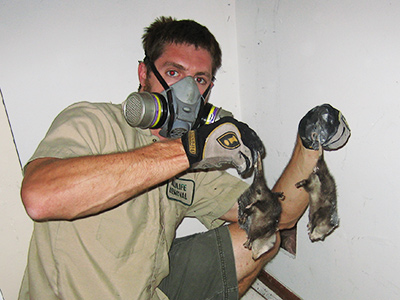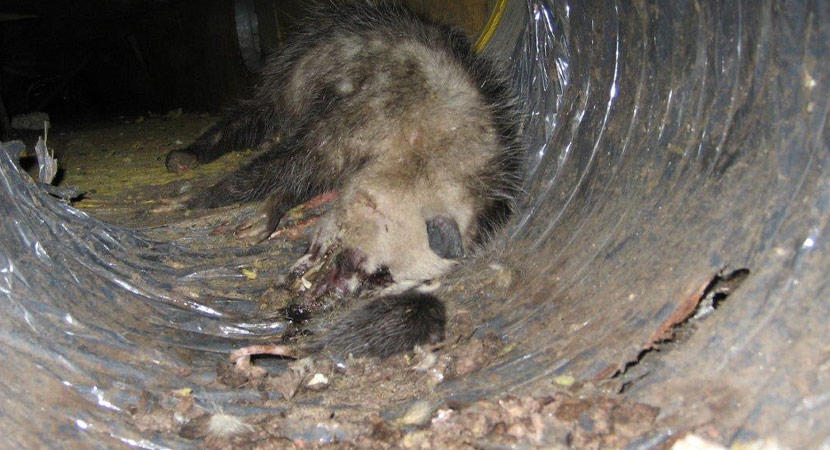Call me: 916-857-9134
Welcome to Sacramento Dead Animal Removal! Got a terrible smell in your house, or do you see a dead critter on your property? We are an animal control company specializing in the removal of dead animals from your home, attic, basement, walls, yard, or any part of your property. You clearly don't want a dead animal in your house. Carcasses attract flies and give off terrible smells, not to mention the potential diseases rotting flesh can cause. Whenever we remove dead animals, we use 100% safe methods and make sure to disinfect your home and get rid of all traces of odor. Click here for Free Roadkill Removal and click here for Dead Pet Body Removal. For deceased wild animals in your home or property, call us anytime at 916-857-9134 to schedule an appointment for today! We come out fast! Some of the services we offer include:
- Dead Animal Removal
- Foul Odor Diagnosis
- Full Property Inspections
- House Damage Repairs
- Dead Body Location Services
- Proper Carcass Disposal
- Cleanup & Decontamination Services
- Deodorization Services
CALL US ANYTIME AT 916-857-9134

Some animals can be a host to different parasites that can transmit diseases. Once the animal dies, they will be looking for a new host, and many of them will feed on humans. Therefore, handling the carcass inside your home without the proper protective gear will expose you to the risk. Our people can ensure that you will be safe from health threats. We understand how dead bodies can be a haven for different bacteria that can cause Salmonella and E. Coli. We also know that it can attract scavengers that are also possible carriers of diseases. Therefore, we will be armed with protective equipment when removing the dead animal. We will also make sure that it will be contained in a sealed box and sent to our incineration facility. We are armed with scientifically-tested products that will kill the bacteria. We provide service for both residential and business owners. Regardless if you have an animal as small as a rodent or as big as a deer, we are appropriately equipped to deal with your issue. With the help of our loyal customers, we have been voted as the #1 dead animal removal company for three years in a row and counting. We treat all our customers with respect. We will make ourselves available even during off business hours and weekends to satisfy their demands.
What Prices Do We Charge?
Learn about dead animal removal costs - each situation is different!
What if you found roadkill or a dead animal such as a deer in a public place, and you want the city or Sacramento County services to remove it for free? Click here for Free Sacramento County Dead Animal Removal services. What if a farm animal like a horse, or your beloved pet dog or pet cat has died and you need the body taken away? Click here for Dead Pet Body Removal.
We are experts in dead animal removal, and take our job seriously. When removing dead animals, we do a COMPLETE job — not only do we remove the dead animal from your home or yard, we also decontaminate the area, deodorize it, and dispose of the animal or cremate it. If you aren't sure whether the stench in your house is due to a rotting carcass or another reason, we can sniff it out with our noses from our years of experience. We remove dead raccoons, dead opossums, dead skunks, dead squirrels, dead birds, even dead dogs and cats. We frequently remove dead rodents from inside walls, because poison kills rats and mice, who die in your house. We completely solve your dead animal problem by taking these steps:
- Sniff out the dead animal if it is somewhere in your home
- When necessary, for example if the animal is in a wall or under your house, cut a hole to remove the animal
- Remove the dead animal, safely and completely (and seal the hole if needed)
- Finish the job by decontaminating and deodorizing your home
- Properly dispose of the dead animal through incineration or other means
- Prevent it from happening again by finding out how they got in your house
Dead animal carcass removal is specialty work. Sometimes the job is simple, such as a dead opossum in the yard, in which case we can simply wear our gloves and respirator mask, bag the carcass, and take it away for incineration. Sometimes this is more complex, such as when the dead animal is under a home crawlspace, under a porch or deck or shed. Or if the animal is larger, such as a dog or a deer. The most complex cases are dead animals inside the house. The animal may have died inside the attic, or down in the walls, or the duct work, or any other part of the architecture. You may have a bad smell in your home, and you're not even sure what's causing it. We've removed not just dead animals, but rotting food, bad mold, etc. We specialize in locating the source of the smell, and we very commonly cut a hole in the ceiling or wall to remove the animal. We remove every bit of the carcass, mop up the juices, vacuum the maggots, spray it and wipe it down with disinfectant, cleaner, and we repair the hole we cut. In some cases we use ozone machines to neutralize odor.
Sacramento Dead Animal Tip: Life Cycle of Fly on Dead Carcass

If there’s a golden rule to life, it’s that nothing is wasted. One animal’s death is another one’s dinner. While a dead animal carcass isn’t particularly appetizing to you or me, it forms a crucial part of their life cycle to certain species of fly.
The most common flies to feature dead carcasses in their life cycle are:
Blowflies
Flesh flies
These two species share many similar features in their life cycle. Below we will discuss flies interchangeable, although there are a few specific differences.
The stage of a fly life cycle
Following the death of an animal, compounds will begin to diffuse into the air. These chemicals are a signal indicating the buffet is open. Flies, finely attuned to such signals, descend upon the carcass en masse. Here, the female flies lay their eggs.
Eggs
300 eggs are laid in clumps
One day from laying to hatching
After the larvae or maggots have hatched, they’ll begin feeding on the fluids generated from microbial decomposition. They’ll also start burrowing into the body, feeding on the dead matter as they go. This is the first ‘instar’ of the fly’s life.
1st larval instar
Feed of bodily fluids
Migrate into body
One day from hatching to the first molt
During the second instar, the maggot will continue to move through the carcass, devouring the meat. Large quantities of larvae will be seen, and the carcass will begin to reduce in size noticeably. You may note that the larvae appear to move in unison as they eat their way through.
2nd larval instar
Maggot mass moves around
Second molt occurs 1-day after the first
The third and final instar triggers the larva to move freely and independently through the carcass. However, the movement only occurs when they need a fresh patch of rotting flesh to eat. Otherwise, they spend every minute of the day eating. During this time, the maggot swells in size, growing rapidly. Here, we see the most dramatic changes in appearance.
3rd larval instar
Larvae begin to move independently
Rapid increase in larval size
From 2nd instar to the pre-pupa stage takes two days
Finally, having completed the maggot stage of life, they move into the pre-pupa phase. Here, the larvae begin to migrate away from the carcass. They are looking for a safe place to start their development into a fully-fledged fly. Having been well-nourished for days, they are as big as they will grow – in their maggot form at least.
Pre-pupa
No feeding
Transforms into pupa
Searches for a suitable location to begin pupation
Phase takes four days
The moment of truth has arrived. The larva enters into the pupal phase, creating a puparium around itself. Inside, complex physiological changes are taking place, shifting the fly’s anatomy and shape. When they finally emerge, they will no longer resemble their maggot form. Instead, they have become the flies with which we are so familiar.
Pupa
Enters into a puparium
Metamorphosis into adult fly body
No feeding
Entire pupa phase takes ten days
The cycle is about to begin again, as the larva has now transformed into an adult fly. Adult flies have a singular purpose: to mate. During this phase, they will search for other flies and start their reproductive phase. Then, once impregnated, the female flies look for a new carcass to lay her eggs. And round the cycle, we go again.
Interesting facts
During the maggot phase, the entire mass generates heat to reach 53oC (127.4oF). To prevent overheating, maggots will cycle between the carcass's inner and outer parts to cool down. An adult female blowfly can lay up to 300 eggs at one time. With enough eggs laid, maggots can consume 60 percent of a human body in less than a week. In as little as four days, the larva will molt twice, transforming from 2mm to 20mm in length. Humans, naturally, find maggots and flies disgusting. We rightfully associate them with disease and decomposition. However, they serve an important ecological and biological function. Without flies and maggots, carcasses would linger substantially longer. They are nature’s vacuum cleaners, working tirelessly to tidy up the messy business of death.
We service nearby towns such as Elk Grove, Folsom, Rancho Cordova, Citrus Heights, Carmichael, Arden-Arcade, Fair Oaks, North Highlands, Galt, Antelope, Orangevale, Rio Linda, Florin, Gold River, Rosemont, Isleton, Rancho Murieta, Walnut Grove, Foothill Farms, McClellan Park, Wilton, Laguna, La Riviera, Vineyard, Herald, Courtland, Franklin, Lemon Hills, Hood, Clay,.